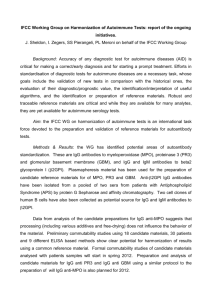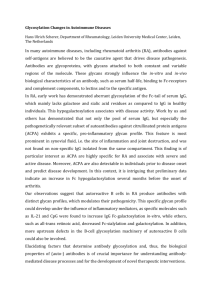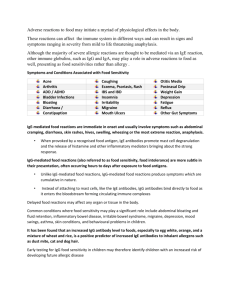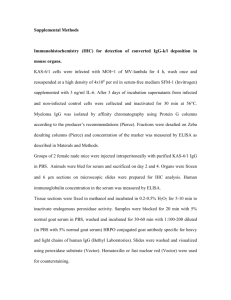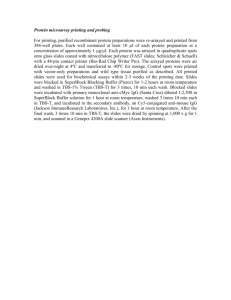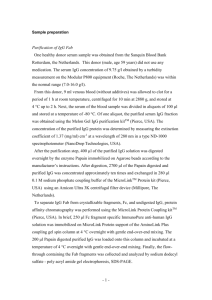Full Text - PDF - Kamla
advertisement
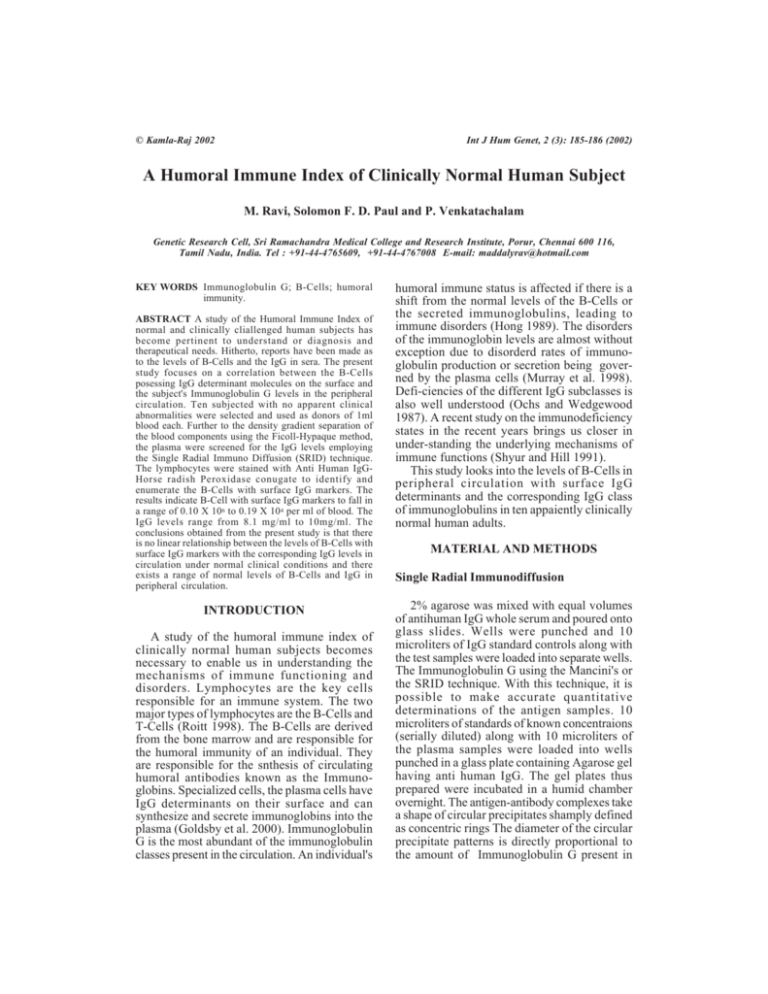
© Kamla-Raj 2002 Int J Hum Genet, 2 (3): 185-186 (2002) A Humoral Immune Index of Clinically Normal Human Subject M. Ravi, Solomon F. D. Paul and P. Venkatachalam Genetic Research Cell, Sri Ramachandra Medical College and Research Institute, Porur, Chennai 600 116, Tamil Nadu, India. Tel : +91-44-4765609, +91-44-4767008 E-mail: maddalyrav@hotmail.com KEY WORDS Immunoglobulin G; B-Cells; humoral immunity. ABSTRACT A study of the Humoral Immune Index of normal and clinically cliallenged human subjects has become pertinent to understand or diagnosis and therapeutical needs. Hitherto, reports have been made as to the levels of B-Cells and the IgG in sera. The present study focuses on a correlation between the B-Cells posessing IgG determinant molecules on the surface and the subject's Immunoglobulin G levels in the peripheral circulation. Ten subjected with no apparent clinical abnormalities were selected and used as donors of 1ml blood each. Further to the density gradient separation of the blood components using the Ficoll-Hypaque method, the plasma were screened for the IgG levels employing the Single Radial Immuno Diffusion (SRID) technique. The lymphocytes were stained with Anti Human IgGHorse radish Peroxidase conugate to identify and enumerate the B-Cells with surface IgG markers. The results indicate B-Cell with surface IgG markers to fall in a range of 0.10 X 106 to 0.19 X 104 per ml of blood. The IgG levels range from 8.1 mg/ml to 10mg/ml. The conclusions obtained from the present study is that there is no linear relationship between the levels of B-Cells with surface IgG markers with the corresponding IgG levels in circulation under normal clinical conditions and there exists a range of normal levels of B-Cells and IgG in peripheral circulation. INTRODUCTION A study of the humoral immune index of clinically normal human subjects becomes necessary to enable us in understanding the mechanisms of immune functioning and disorders. Lymphocytes are the key cells responsible for an immune system. The two major types of lymphocytes are the B-Cells and T-Cells (Roitt 1998). The B-Cells are derived from the bone marrow and are responsible for the humoral immunity of an individual. They are responsible for the snthesis of circulating humoral antibodies known as the Immunoglobins. Specialized cells, the plasma cells have IgG determinants on their surface and can synthesize and secrete immunoglobins into the plasma (Goldsby et al. 2000). Immunoglobulin G is the most abundant of the immunoglobulin classes present in the circulation. An individual's humoral immune status is affected if there is a shift from the normal levels of the B-Cells or the secreted immunoglobulins, leading to immune disorders (Hong 1989). The disorders of the immunoglobin levels are almost without exception due to disorderd rates of immunoglobulin production or secretion being governed by the plasma cells (Murray et al. 1998). Defi-ciencies of the different IgG subclasses is also well understood (Ochs and Wedgewood 1987). A recent study on the immunodeficiency states in the recent years brings us closer in under-standing the underlying mechanisms of immune functions (Shyur and Hill 1991). This study looks into the levels of B-Cells in peripheral circulation with surface IgG determinants and the corresponding IgG class of immunoglobulins in ten appaiently clinically normal human adults. MATERIAL AND METHODS Single Radial Immunodiffusion 2% agarose was mixed with equal volumes of antihuman IgG whole serum and poured onto glass slides. Wells were punched and 10 microliters of IgG standard controls along with the test samples were loaded into separate wells. The Immunoglobulin G using the Mancini's or the SRID technique. With this technique, it is possible to make accurate quantitative determinations of the antigen samples. 10 microliters of standards of known concentraions (serially diluted) along with 10 microliters of the plasma samples were loaded into wells punched in a glass plate containing Agarose gel having anti human IgG. The gel plates thus prepared were incubated in a humid chamber overnight. The antigen-antibody complexes take a shape of circular precipitates shamply defined as concentric rings The diameter of the circular precipitate patterns is directly proportional to the amount of Immunoglobulin G present in 186 - September 2002 M. RAVI, SOLOMON F. D. PAUL AND P. VENKATACHALAM the plasma samples and the same were measured and documented. Identification and Enumeration of B-Lymphocytes Lymphocyte suspension as derived by density gradiant separation of blood was obtained. These cells were subjected to antihuman IgG-HRP conjugate. B-Cells were distinctly stained brown owing to the presence of surface IgG determinants thereby facilitating their identification and cnumcration. RESULTS The results suggest a range of values for the B-Cells levels and also for the IgG present in the peripheral circulation, in clinically normal human adults. The B-Cells levels were in the range of 0.10 x 106ml to 0.19 x 106/ml. The IgG levels were in the range of 6.80 mg/ml to 10.0 mg/ml. There was apparantely not much of a correlation between the B-Cell leyels and the IgG present in the circulation. The results are tabulated in table 1. Table 1: IgG concentrations in the test samples as obtained by the Manclni's technique and the corresponding B-Cell levels Standard Values S. No. IgG Concentration/ml 1. 2. 3. 4. Preciptin Diameter 11.00 10.00 9.00 8.00 12.10 11.00 9.00 8.00 DISCUSSION IgG is the most abundant immunoglobulin of serum (70-75%). IgG antibodies are produced in response to the antigens of most bacteria and viruses and to small protein antigens. Deficiency of IgG may be due to protein loss, an inherited defect in synthesis, acquired defects in production, immunosuppressive drugs or toxins, or secondary to lymphoipd malignancy such as multiple mycloma and chronic lymphocytic leukemia. A poly clonal increase in serum IgG tends to predominate in autoimmune diseases. Disorders of immunoglobulins include increased production of specific classes of immunoglobulins or ever specific immunoglobulins or even specific immunoglobulin molecules, the later by clonal tumors of plasma cells called myelomas. Hypogammaglobulinemia may be restricted to a single class of immunoglobulin molecule (eg. IgG) or may involve under production of all classes of immuno-globulins. A normal working of the immune mechanisms must be understood to enlighten us about the immunodeficiency or other abnormal states. The ability to dissect a given dysfunction and pinpoint its cellular and molecular origin enriches our knowledge of the immune system and this can lead to marked improvement in the treatment of immunodeficiency and other disorders. As B-lymphocytes are the primary sources of the effector humoral IgG molecules, a study of normal levels of the B-Cells and the IgG in the peripheral circulation becomes necessary for various age groups and human pockets and hence this styd. IGG and B-Cell Levels of Test Samples S. No. 1. 2. 3. 4. 5. 6. 7. 8. 9. 10. Precipitin Diameter IgG Concentration /ml B-Cell levels /ml (x 106) 10.2 9.0 10.0 11.0 10.0 7.50 10.2 10.1 10.6 10.8 9.30 8.10 9.10 10.0 9.10 6.80 9.40 9.30 9.60 9.60 0.14 0.10 0.12 0.19 0.17 0.16 0.18 0.17 0.18 0.17 REFERENCES 1. 2. 3. 4. 5. 6. Goldsby RA, Kundt TJ, Obsorne BA 2000. Kuby Immunology. 4th edition. W.H. Freeman and Company. Hong R 1989. Update on immunodeficiency diseases. Am J Dis Child, 144: 983-992. Murray RK, Granner DK, Mayes PA, Rodwell VW 1998. Harper's Biochemistry. 24th edition. Prentice Hall International Inc. Ochs HD, Wedgewood RJ 1987. IgG subclass deficiencies. Ammu Rev Med, 38: 325-340. Roitt IM 1988. Essential Immunology. 5th edition. English Language Book Society/Blackwell Scientific Publications. Shyur SD, Hill HR 1991. Immunodeficiency in the 1990s. Peddiatr Infect Dis J, 10: 595-611.

